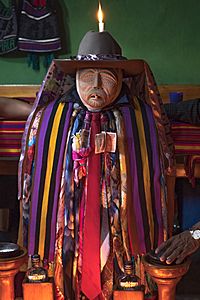Maximón facts for kids
Quick facts for kids Maximón |
|
|---|---|

Maximón effigy and candles, Santiago Atitlán
|
|
| Ri Laj Mam, Don Ximon, San Simón, El Gran Abuelo | |
| Born | October 28th |
| Venerated in | Traditionalist Maya Communities |
| Attributes | sunglasses, bandana, colorful garlands |
| Patronage | health, crops, marriage, business, and helping with tough problems |
Maximón, also known as San Simón, is a special figure for the Maya peoples in the Guatemalan Highlands. People in different towns have their own ways of showing respect to him. The stories about how he came to be and what he does are very old. They come from ancient Maya traditions that are hundreds of years old.
Contents
Who is Maximón?
People believe that Maximón's worship started when the Spanish arrived in Maya lands a long time ago. He became known as a "saint" because people mixed old Maya beliefs with new Christian ideas. This mixing of beliefs is called religious syncretism.
Experts think that Maximón's character is a blend of several important figures. These include historical people, characters from the Bible, and figures from Maya myths. Some of these are Pedro de Alvarado, Judas Iscariot, Saint Peter, and Mam.
Maximón looks different depending on where you are. He is often shown as a man wearing a suit and a hat. But in Santiago Atitlán, he wears bright garlands and scarves. In Zunil, he is seen with sunglasses and a bandana.
Maximón's Stories
Maximón is said to represent both good and bad, and he can be a bit of a trickster. He is also seen as a protector of couples.
Some legends say that Maximón was once an elder named Ri Laj Mam. He was reborn to protect his people. During the Spanish Conquest, Ri Laj Mam was upset by the Spanish. He encouraged his people to fight back. He was eventually killed, but he came back to life as a judge named Don Ximon. This judge worked to give land back to the native people of Guatemala.
In Santiago Atitlán, there is a story that Maximón was never a man. He was a wooden figure made by shamans (spiritual healers). They created him to protect the village from witches. However, Maximón sometimes used tricks to harm the villagers. So, the shamans twisted his head around and broke his legs to stop him. After that, he did his job properly and protected the town from evil.
Showing Respect to Maximón

People show respect to Maximón through a special statue or image of him. How they do this changes a lot from place to place. In Santiago Atitlán, Maximón's statue stays in a different family's home each year. His image is usually only brought out during Holy Week. After this, it moves to a new house. However, because many people visit him, the statue is often on display all year.
Special helpers stay with the statue all year. They give offerings from visitors to Maximón. Common offerings include money, tobacco, and a strong alcoholic drink.
In the town of San Andrés Itzapa, there is a large temple for Maximón. Here, shamans burn offerings like corn, flowers, and candles for him in public. People travel to this temple from all over Latin America.
Some news reports in Guatemala have said that fewer people are worshipping Maximón now. But it is hard to know for sure if this is true.
Maximón Outside Guatemala
Many Guatemalans have moved to places like Mexico, the United States, and Canada. Because of this, the worship of Maximón has spread beyond Guatemala's borders. In these new places, he is more commonly known as San Simón. There are temples dedicated to him in New York, California, and Florida.
Images for kids
See also
 In Spanish: Rilaj Maam para niños
In Spanish: Rilaj Maam para niños





